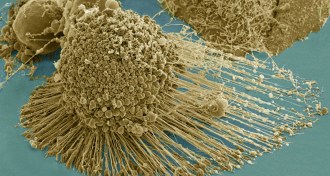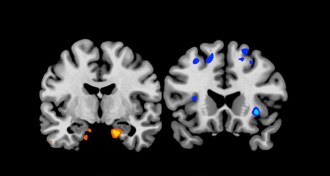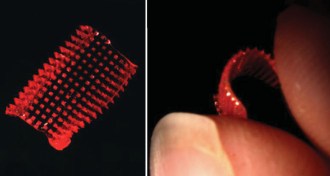Uncategorized
-
 Science & Society
Science & SocietyHeLa genome offers clues to cells’ cancerous nature
The genetic sequence is published along with an agreement to protect the privacy of the family of the cells’ provider, Henrietta Lacks.
-
 Science & Society
Science & SocietyFlu researchers plan to repeat controversial work
The scientists who made the H5N1 strain transmissible between ferrets intend to do the same with H7N9.
-
 Animals
AnimalsClimate change may bring dramatic behavior shifts
Shifting temperatures and rainfall are expected to alter animal lifestyles from the poles to the tropics.
By Susan Milius -
 Neuroscience
NeuroscienceOne sleepless night weakens resolve in the face of doughnuts
Sleep loss changes brain activity and food preferences.
-
 Health & Medicine
Health & MedicineSpace-mapping neurons found in human brain
Grid cells may orient people in Euclidean space.
-
 Space
SpaceLong the stuff of fantasy, wormholes may be coming soon to a telescope near you
For decades now, black holes have been the rock stars of popular astrophysics, both fact and fiction. Physicists rely on them to explain all sorts of mysterious astrophenomena, and black holes have been essential plot devices in various films, from Star Trek (2009) to Galaxy Quest (1999) to (obviously) The Black Hole (1979). But black […]
-
 Tech
TechBandage-like patch dissolves to deliver medicine to skin
Flexible material gets drugs or vaccines into body painlessly.
By Meghan Rosen -
 Animals
AnimalsSpider’s personality matters when job hunting
Boldest individuals of social species tasked with seeking out prey.
By Meghan Rosen -
 Life
LifeEvolution of mammalian monogamy remains mysterious
Two large studies reach opposing conclusions about why males stay with females.
-
 Physics
PhysicsDoppler effect takes a spin
Light’s twistiness allows researchers to measure rotating object’s speed.
By Andrew Grant -
 Humans
HumansY chromosome analysis moves Adam closer to Eve
A pair of genetic studies has pushed back age of men's most recent common ancestor.
By Erin Wayman -
 Neuroscience
NeuroscienceCamping resets internal clock
After a week in the wild, people went to bed and got up earlier.
By Meghan Rosen